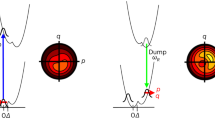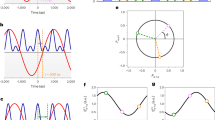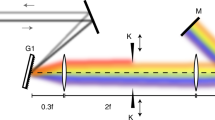Abstract
THE critical stage in a chemical reaction — the progression through the transition state from reagents to products — occurs in less than a picosecond (10−12 s). Using laser pulses of femtosecond (10−15 s) duration it is possible to probe the nuclear motions throughout formation and break-up of the transition state1,2. The coherence and very short duration of these femtosecond pulses provides a means to influence the course of the reaction during this stage if the time resolution is made sufficiently short. Here we describe a demonstration of such control of a chemical reaction on the femtosecond timescale. Using two sequential coherent laser pulses, we can control the reaction of iodine molecules with xenon atoms to form the product XeI by exciting the reactants through the transition state, in a two-step process. The yield of product XeI is modulated as the delay between the pulses is varied, reflecting its dependence on the nuclear motions of the reactants.
This is a preview of subscription content, access via your institution
Access options
Subscribe to this journal
Receive 51 print issues and online access
$199.00 per year
only $3.90 per issue
Buy this article
- Purchase on Springer Link
- Instant access to full article PDF
Prices may be subject to local taxes which are calculated during checkout
Similar content being viewed by others
References
Zewail, A. H. Science 242, 1645–1653 (1988).
Khundkar, L. R. & Zewail, A. H. Ann. Rev. phys. Chem. 41, 15–40 (1990).
Polanyi, M. Atomic Reactions (Williams and Norgate, London, 1932).
Polanyi, J. C., Xu, G-Q. & Zeng, H-C. Faraday Discuss. Chem. Soc. 91, (1991).
Okada, F., Wiedeman, L. & Apkarian, V. A. J. Phys. Chem. 93, 1267–1272 (1989).
Levine, R. D. & Bernstein, R. B. Molecular Reaction Dynamics and Chemical Reactivity (Oxford University Press, 1987).
Donovan, R. J. et al. Faraday Discuss. Chem. Soc. 84, 221–238 (1987).
Qin, J., Nelson, T. O. & Setser, D. W. J. phys. Chem. 95, 5374–5378 (1991).
Bowman, R. M., Dantus, M. & Zewail, A. H. Chem. Phys. Lett. 161, 297–302 (1989).
Qin, J. & Setser, D. W. Chem. Phys. Lett. 184, 121–127 (1991).
O'Grady, B. V. & Donovan, R. J. Chem. Phys. Lett. 122, 503–506 (1985).
Donovan, R. J., Holmes, A. J., Langridge-Smith, P. R. R. & Ridley, T. J. chem. Soc. Faraday Trans. 85(2), 541–548 (1988).
Felker, P. M. & Zewail, A. H. Phys. Rev. Lett. 53, 501–505 (1984).
Bloembergen, N. & Zewail, A. H. J. phys. Chem. 88, 5459–5465 (1984).
Tannor, D. J. & Rice, S. A. Adv. Chem. Phys. LXX (Part I), 441–523 (1988).
Manz, J. & Parmenter, C. S. Chem. Phys. 139, 1–4 (1989).
Mukamel, S. & Shan, K. Chem. Phys. Lett. 117, 489–494 (1985).
Sleva, E. T., Glasbeek, M. & Zewail, A. H. J. phys. Chem. 90, 1232 (1986).
Brumer, P. & Shapiro, M. Chem. Phys. Lett. 126, 541–546 (1986).
Shi, S., Woody, A. & Rabitz, H. J. chem. Phys. 88, 6870–6883 (1988).
Combariza, J. E., Manz, J. & Paramonov, G. K. Faraday Discuss. Chem. Soc. 91 (1991).
Butler, L., Hintsa, E. J., Shane, S. F. & Lee, Y. T. J. chem. Phys. 86, 2051 (1987).
Vander Wal, R. L., Scott, J. L. & Crim, F. F. J. chem. Phys. 92, 803 (1990).
Zhang, L., Fuss, W. & Kompa, K. L. Chem. Phys. 144, 289–297 (1990).
Park, S. M., Lu, S-P. & Gordan, R. J. J. chem. Phys. 94, 8622–8624 (1991).
Gerdy, J., Dantus, M., Bowman, R. M. & Zewail, A. H. Chem. Phys. Lett. 171, 1–4 (1990).
Scherer, N. F., Ruggiero, A. J., Du, M. & Fleming, G. R. J. chem. Phys. 93, 856–857 (1990).
Amstrup, B., Carlson, R. J., Matro, A. & Rice, S. A. J. phys. Chem. 95, 8019–8027 (1991).
Jouvet, C., Boivineau, M., Duval, M. C. & Soep, B. J. phys. Chem. 91, 5416–5422 (1987).
Barnes, M. D., Brooks, P. R., Curl, R. F. Jr & Harland, P. W. J. chem. Phys. 94, 5245 (1991).
Kleiber, P. D., Lyyra, A. M., Sando, K. M., Heneghan, S. P. & Stwalley, W. C. Phys. Rev. Lett. 54, 2003 (1985).
Breckenridge, W. H., Jouvet, C. & Soep, B. J. chem. Phys. 84, 1443 (1986).
Author information
Authors and Affiliations
Rights and permissions
About this article
Cite this article
Potter, E., Herek, J., Pedersen, S. et al. Femtosecond laser control of a chemical reaction. Nature 355, 66–68 (1992). https://doi.org/10.1038/355066a0
Received:
Accepted:
Issue Date:
DOI: https://doi.org/10.1038/355066a0
This article is cited by
-
Controlling the electro-optic response of a semiconducting perovskite coupled to a phonon-resonant cavity
Light: Science & Applications (2023)
-
Imaging and controlling coherent phonon wave packets in single graphene nanoribbons
Nature Communications (2023)
-
Polaritonic molecular clock for all-optical ultrafast imaging of wavepacket dynamics without probe pulses
Nature Communications (2020)
-
Coherent control of a surface structural phase transition
Nature (2020)
-
Coherent structural trapping through wave packet dispersion during photoinduced spin state switching
Nature Communications (2017)
Comments
By submitting a comment you agree to abide by our Terms and Community Guidelines. If you find something abusive or that does not comply with our terms or guidelines please flag it as inappropriate.



